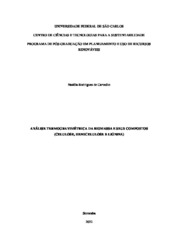Análise termogravimétrica da biomassa e seus compostos (celulose, hemicelulose e lignina)
Abstract
Lignocellulosic biomass is one of the renewable energies indicated in the replacement of fossil fuels for the production of bioenergy and mitigation of climate change, given its wide distribution and quantity, considering the different types of biomass and its residues. However, it is necessary to study the thermal behavior of biomass in order to achieve greater energy efficiency. A usual methodology to understand the thermal behavior of biomass is thermogravimetric analysis (TGA). As lignocellulosic biomass has a complex and heterogeneous composition, in TGA the decomposition ranges of its compounds overlap at some points. Thus, thermogravimetric analysis of biomass-cellulose, hemicellulose and lignin compounds has been used; in order to elucidate the degradation ranges and parameters of each constituent separately and how they interfere in the thermal degradation of in natura biomass. The objective of this work was to thermally analyze the biomass of eucalyptus wood chips and sugarcane bagasse, as well as their compounds – cellulose, hemicellulose and lignin; in order to understand more about the combustion and pyrolysis processes of biomass. Proximate analysis and chemical analysis of the biomasses were performed to obtain the components of the biomass and analyze in thermogravimetry. The materials analyzed were: microcrystalline cellulose, cotton, xylose, kraft and organosolv lignins, eucalyptus chips (in natura, without extractives, holocellulose, alphacellulose, lignin) and sugarcane bagasse (in natura, without extractives, holocellulose, alphacellulose, lignin). The xylose DTG curve showed two degradation peaks before 350 °C and stabilized the degradation near 400 °C, indicating less resistance to thermal degradation. The DTG curves for cotton, microcrystalline cellulose, alpha cellulose from eucalyptus chips and alpha cellulose from sugarcane bagasse showed a narrow degradation range and a sharp peak of maximum degradation around 300-400 °C. The DTG curves of lignins (kraft lignin, orgnosolv lignin, eucalyptus lignin and bagasse lignin) showed a less pronounced degradation, covering wide temperature ranges - between 270 and 560 °C, proving the stability and resistance of the material to thermal degradation. Sugarcane bagasse proved to be more thermally stable than eucalyptus. In general, for both eucalyptus and bagasse, the TG and DTG curves of in natura biomass, without extractives, holocellulose and alphacellulose were similar, but there was a gradual omission of the peak corresponding to the deflection temperature before the point of deflection. maximum decomposition (Tsh) and the narrowing of the base of the maximum degradation peak in the DTG curve, a behavior that is probably associated with the loss of secondary/extractive compounds and hemicellulose. To accurately plot the TG and DTG curves, as well as perform kinetic studies, it is recommended to use different heating rates.
Collections
The following license files are associated with this item:

